How long do you think the average call duration is for call centers? The answer might surprise you. The average call duration across all types of call centers is 5.97 minutes—not too bad, but not as good as we hoped. It’s safe to say there’s always room for improvement when it comes to customer service, and it all starts with contact center best practices.
Currently, 86% of customers are willing to pay more for an upgraded experience. Start improving the customer experience by upping your contact center game. With so much technology at your fingertips, what are you waiting for? If you’re thinking that your current contact center setup is fine as is, think again. According to a recent study:
- 60% of agents agree that their company doesn’t always provide the technology that staff need to address the challenges they face when helping customers.
- 34% of agents believe they don’t have the right customer data available at the time of request.
- Only 31% of companies strictly monitor the quality of relations with target customers.
Below, you’ll learn top contact center best practices to increase agent productivity and wow your customers.
🔍 Access Metrigy’s free report to learn more about the 2022 state of customer experience technology.
1. Keep your eye on the customer experience
Before diving into the nitty-gritty of contact center best practices, it’s always important to remember the purpose of contact centers: to deliver an amazing customer experience. If customers aren’t walking away from your contact center feeling satisfied, then your contact center isn’t working.
As you think about new ways to strategize your contact center, always ask yourself, “Will this help improve the customer experience?” Use this question as your North Star as you make important business decisions regarding your contact center. To remind you why the customer experience is so important, here are some key stats to keep in your back pocket:
- By delivering a great customer experience, customers will happily pay a 16% premium on your products and service.
- 61% of consumers say that they have stopped transacting with a business after a poor service experience.
- 59% of customers will walk away after several bad experiences and 17% after just one bad experience.
How does your customer experience, agent productivity, and overall business strategy measure up to that of your peers? Take the contact center maturity quiz and get personalized recommendations to edge out the competition.
2. Move to the cloud ASAP
If you haven’t already, it’s time to move your contact center to the cloud. According to a Call Centre Helper survey, 21% of contact centers have moved to the cloud, with almost three times the number either in-process, in-planning, or considering implementation.
In fact, COVID-19 is accelerating the shift to cloud networking, and the global cloud-based contact center market is expected to reach $44.86 billion by 2025. There are numerous reasons why you should move to the cloud, with two of them being it’s more mobile-friendly and efficient than legacy PBX systems. Don’t believe us? Take the word of the National Automobile Dealers Association (NADA), who recently moved their contact center to the cloud.
Prior to upgrading to RingCentral’s cloud-based contact center, NADA was using a dated on-premises voice over IP (VoIP) system that caused too many issues and headaches. As the company was forced to go remote amid the pandemic, they were able to deploy RingCentral Contact Center without a hitch and support their workforce to work from anywhere. Rafael Maldonado, Vice President and CIO of NADA, shared his experience.
“If we could enable our staff to be more nimble, efficient, and effective in our mission of servicing our members, we wouldn’t be limited by a building. RingCentral was one of those steps in us being able to get the work done from anywhere on any device.”
And if you think moving to the cloud is going to be a pain and a long process, think again.
“When the announcement came, I reached out to our partners at RingCentral. We had our questions answered quickly, underwent some training, and got everybody up and running and working right away. It was not as difficult as I thought it was going to be, and it works pretty seamlessly.”
3. Prioritize reliability
When it comes to contact center best practices, reliability should be at the top of your list. After all, what’s the point of having a contact center if it’s not reliable? Customers want to connect fast and don’t want to deal with voice quality issues.
Make sure you do your research and get a contact center that is industry-leading with a 99.999% uptime SLA so that your contact center works day and night to keep agents online and available, all the time.
Let’s take a closer look at the law firm Thompson Law to see how they upgraded to a more reliable contact center. Before switching to RingCentral Contact Center™, Thompson Law was using a legacy, on-premises phone system that was unreliable and causing too many issues. Kirk Lee, IT consultant for Thompson Law, shared his experience with the old system.
“We also had downtime problems. Because everything ran through the PBX, if we lost power at the office, we’d lose our entire phone system. This firm lives by its ability to stay accessible to clients and prospects. If we don’t have a working phone system, then we’re not getting cases.”
After moving to the cloud with RingCentral Contact Center and RingCentral Office®, the team experienced no downtime issues.
“We don’t have downtime issues anymore. As mission-critical as a reliable phone system is to our operations, that benefit alone would’ve made migrating to RingCentral worth it.”
4. Get omnichannel flexibility
If you’re not familiar with the term “omnichannel,” get used to it. An omnichannel contact center helps you connect with your customers on their channel of choice, whether through phone, web chat, email, social media, self-serve options, or any other digital channel.
Remember, people want to communicate on the channel that is most convenient for them, at whatever time they choose, from any location. For example, keep the following scenarios in mind when thinking about which channel works best for your customers:
- When someone is on your website, asynchronous chat or messaging will be easiest.
- When someone is driving their car, being able to escalate to voice is safest.
- When someone is surfing your mobile app, proactively message them directly through the app.
- When someone is on your Facebook page, avoid the unnecessary voice interaction, and keep the conversation going on social media.
With omnichannel contact centers, you can give customers a say in how they want to communicate. Just remember to keep live agents in the mix given 64% of organizations in the industry believe that customers should have access to a live agent.
Try not to feel limited to just one channel throughout the entire customer experience. With RingCentral Engage Digital™, you can keep conversations going by letting customers start a chat on the web and pick it up later on their mobile device, whether through Facebook Messenger, WhatsApp, SMS, or other popular mobile apps. No matter what digital channel your customer prefers, you can easily manage all responses in one place.
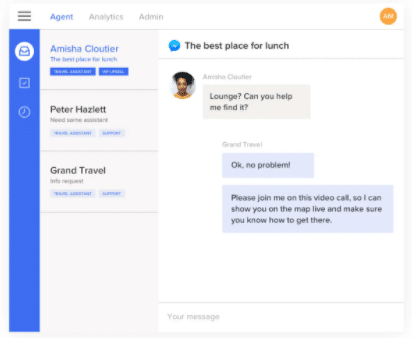
With two out of three consumers thinking that omnichannel customer service is getting better, you don’t want to miss out on this opportunity to become a true omnichannel contact center.
What does Contact Center 2.0 look like? Stay ahead of the curve with our free eBook: Contact Center 2.0: Tomorrow’s solutions for today’s customers.
5. Reduce long wait times with virtual holds and skills-based routing
You can’t expect to go over contact center best practices without addressing long wait times. Long wait times have been a constant struggle for customers and businesses alike. We’ve all been there, and we never forget the frustrations that come with it. How can we reduce long wait times so that customers don’t feel neglected?
For starters, upgrade your contact center to include virtual holds. With virtual holds, customers don’t need to wait in a long queue. Instead, they’re given the option to have an agent call them back while keeping their place in line.
Second, reduce resolve times by immediately connecting customers to the right agent. No customer wants to get routed to 10 different agents and have to repeatedly provide their data. In fact, 33% of consumers say that the most important aspect of a good customer service experience is resolving an issue in one interaction, and 31% say that a knowledgeable customer service representative is the most important aspect.
Connect customers to the best-matched agent faster with skills-based routing. Kirk from Thompson Law shares how the firm is winning with new routing features. Before upgrading to RingCentral Contact Center, Kirk explained:
“Because we didn’t have much of a routing feature, most calls went straight to our receptionists. We were overwhelming our front-desk staff with transferring calls, and not creating a great experience for callers. Worse, this process was so inefficient that we had to pay for a third-party call center to handle overflow.”
Now, with RingCentral Contact Center, Thompson Law is improving efficiency and saving costs with new routing capabilities.
“We route inbound prospect calls to our Intake Phase 1 team of experts, and when that queue is full, we’re able to automatically send overflow calls to second, third, and even fourth-level teams. This lets us finally eliminate that expensive third-party call center bill.”
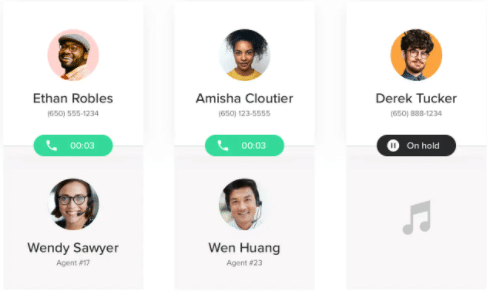
6. Don’t underestimate the power of integrations
While it’s important to immediately connect your customers to the right agents, it’s equally important to ensure your agents have the right customer information close at hand. For example, when a call comes in, have all customer information pop up in front of the agent so that he/she can be better prepared and resolve problems quicker. This type of setup leads to a better customer experience—not only does it speed up resolve times, but it also saves your company lots of money. How can you get this setup across your workplace? Well, it’s simple: through the power of integrations.
If your contact center has the ability to integrate with other software that your team is already using (especially your CRM system), take it! This will instantly improve the flow of work and make everyone’s job easier.
Let’s take the employee management consultancy Peninsula as an example. The company is optimizing their workflows with RingCentral’s integration with the popular CRM system Salesforce. Omar, IT Manager at Peninsula, shared:
“Another great benefit we’ve found with RingCentral has been the ability to integrate it with our other productivity apps. We’ve integrated RingCentral into our Salesforce Lightning environment, which lets our salespeople work from one pane of glass. When a rep is reviewing an account in Salesforce and wants to call that prospect or customer, they no longer have to copy and paste the phone number or dial it manually. Now they can just click to dial right from Salesforce.”
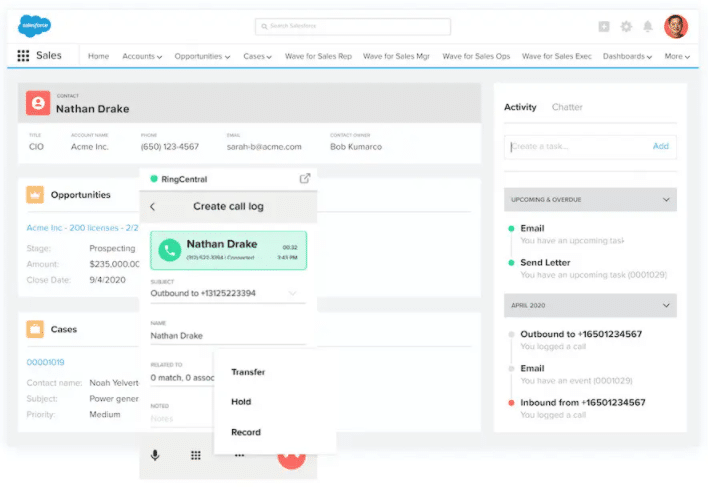
With integrations, your agents no longer need to toggle between multiple apps to get work done—it’s all in one spot.
Curious if your existing apps integrate with RingCentral Contact Center? Access the full list of RingCentral integrations.
7. Improve the way you approach agent coaching
Do you ever sit in on agent calls to see how they’re interacting with customers? Start monitoring and recording agent calls so you can find areas for improvement. Listen closely to gain valuable insights on agent performance and the customer experience. This exercise can help you coach your team towards better customer service.
To further improve agent performance, look at tools that let you schedule, deliver, and track agent coaching. With today’s technology, you can find tools, like RingCentral Contact Center, that are integrated with individual quality monitoring evaluation scores and KPIs. Getting your hands on the right coaching tools and resources can help your customer support team deliver first-rate service.
Attention supervisors! Learn how to better manage teams of remote contact center agents with our free eBook and videos.
8. Invest in advanced analytics
Did you know 66% of call center businesses are looking forward to investing in advanced analytics to provide a better customer journey? Don’t strategize in the dark—turn to advanced analytics with real-time reports tying the customer experience to employee performance. Look at both overall contact center reports and individual agent performance reports to improve service quality and productivity.
For example, at Essential Federal Credit Union (FCU), the team turns to detailed reports to find new ways to increase efficiency. Catrice Lee, Center Manager at Essential FCU, shared how the business has improved with new reports supplied by RingCentral Contact Center.
“Thanks to the detailed reports I can pull and review anytime, we have such great visibility into our call traffic. For example, we now finally have data showing our inbound calls fall sharply at night. That insight alone has allowed us to reallocate resources more efficiently.”
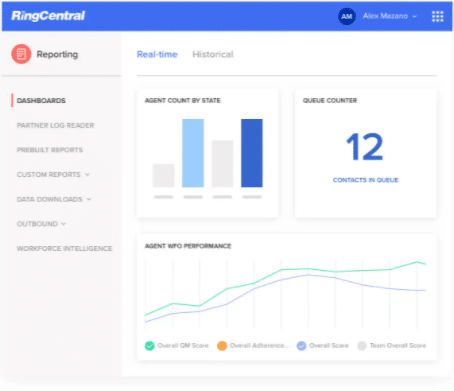
Let’s look at another example: Peninsula, an employee management consultancy, turns to data insights to improve scheduling. Omer Subedar, IT Manager at Peninsula, shared:
“When we began tracking all of our client calls with Contact Center, we found something interesting. We assumed the HR experts in our support center would experience high call volumes during normal business hours, but then fall off sharply after hours. Turns out that was wrong. Calls from our clients do slow down after 5:00 p.m., but then they begin picking up again about 8:00 p.m…. Thanks to insights like these, we’ve been able to more effectively schedule our HR experts’ schedules to cover the phones 24/7. And we wouldn’t have uncovered these patterns without RingCentral Contact Center.”
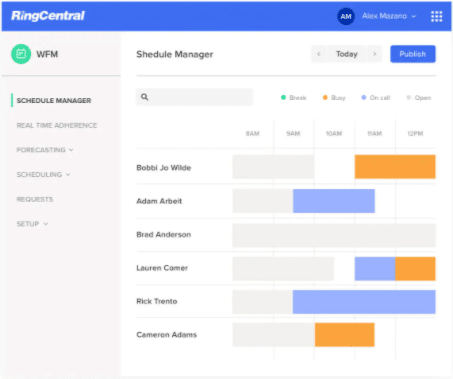
Similar to Peninsula, use actionable insights to optimize agent schedules. This will maximize coverage and minimize idle time so customers aren’t left in the cold during peak times and agents aren’t idle during quiet times.
When it comes to call center metrics, are you tracking the right ones? Find out in this blog post.
9. Step up your proactive outreach
What do your outbound efforts look like? Have a contact center in place that supports outbound initiatives—you want to create a proactive customer experience that sells, not just takes inbound requests. Use your outbound contact center to upsell, cross-sell, collect, and promote your business.
With tools like RingCentral Engage Voice™, you can make the most out of every conversation with manual, preview, progressive, and predictive dialers. Agents can even take advantage of personalized on-brand scripts tailored to every customer and automated outbound campaigns. Make your contact center an unstoppable inbound and outbound machine.
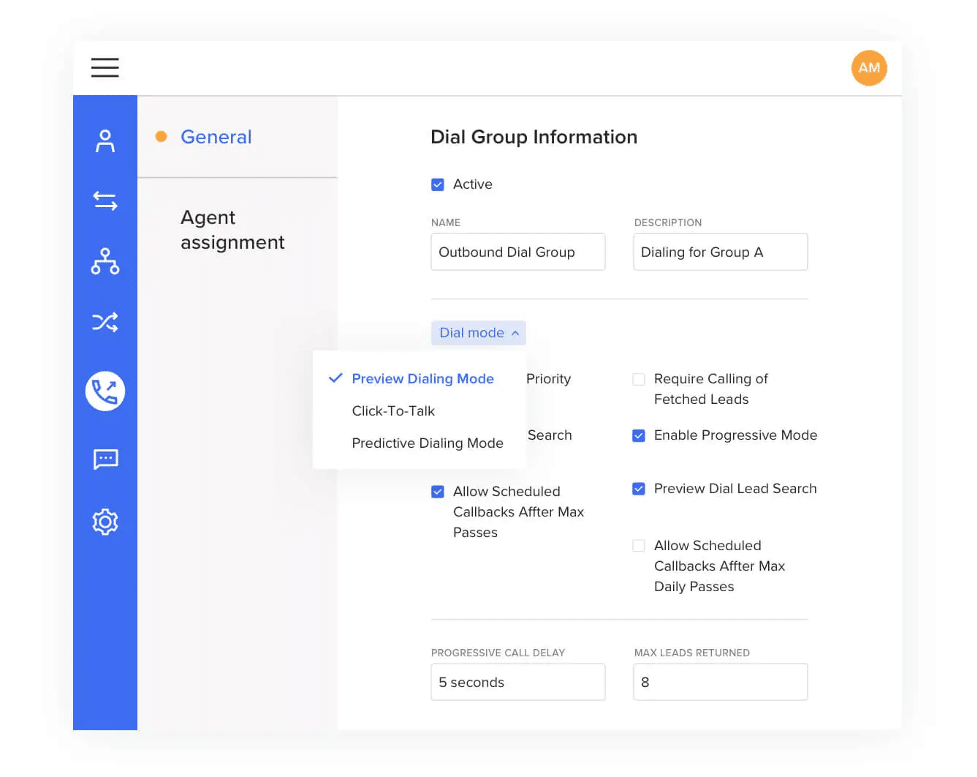
Looking for a go-to guide for outbound contact centers? Look no further. Grab the outbound engagement playbook to create a proactive customer experience today.
10. Do more with less effort through automation
There are a number of automation features you can now tap into to enhance your contact center. Don’t be afraid of a little automation—it’s made to improve the customer experience, not replace agents.
With self-service capabilities, you can let customers perform routine operations over the phone by themselves and clarify their needs for more personalized service. Think about how much time both your customers and agents can save with a feature like this.
Consider adding a virtual agent into the mix. An AI-powered virtual agent is more effective than a standard chatbot—it uses technology like machine learning and natural language processing (NLP), which makes it an active participant in conversations, acting more like a human. With virtual agents, common questions can be handled faster. Imagine how many general inquiries can be resolved faster with a chatbot in place.
11. Have fun with gamification
Motivate and engage your agents with gamification. With gamification, you can change it up and give agents challenges, badges, and prizes for hitting milestones. Agents will have fun reaping rewards, and at the same time, managers can track how agents are performing compared to the rest of the team. Gamification is a clear win-win for both managers and agents.
For example, offer a massive reward such as a large cash prize or the hottest tech gadget to the top-performing agent of the quarter. Agents will be motivated to climb the ranks, and managers can refer to the leaderboard to monitor progress. You can even offer second and third place prizes to widen your reward offerings.
12. Support and train your agents
Sounds simple enough, right? If only it were that easy. Agents need ongoing support, whether it’s the right tools, coaching techniques, or training workshops. Gather feedback from your agents on a regular basis to understand their challenges. And once you gather their feedback, don’t just sit on the sidelines—take action on their feedback so they feel heard.
Atop of active listening, equip your agents with tools that are intuitive and easy to use. This is especially important given the call center industry in the US faces an overall average turnover rate of 30–45%. You want to get a contact center solution that’s quick to learn for new hires and engaging for current employees. Don’t steer your agents in the wrong direction with a complicated contact center solution that makes them want to run out the door.
Need more training resources for your agents? Share this list of 10 must-have customer service skills for 2021.
13. Get top-tier security and customer support
Have peace of mind with a contact center solution that has seven layers of security to protect your data across the board. Look for built-in security that encrypts conversations between all endpoints and instills security measures at every level, including your physical, network, host, data, application, and business processes. Don’t let your business be vulnerable to security attacks with top-tier security in place.
Also, don’t feel like you’re alone when it comes to managing your contact center. Find a vendor that offers 24/7 support by phone, chat, and email. If you’re looking to implement a new contact center solution, choose a vendor that offers a support system of experts and resources to ensure a fast and successful deployment.
14. Unified solutions are the way to go
Who says you can’t have it all? Don’t settle for just a contact center solution. Get an integrated, unified contact center and communications solution from one vendor. At the moment, 62% of organizations think that the biggest challenge in making future investments will be integrating with current call center software. With RingCentral, you don’t need to worry about this.
With the integration of RingCentral Contact Center with RingCentral Office, you can tap into all of RingCentral’s contact center and communications features. This makes collaboration much easier and gives your team full access to omnichannel flexibility, workforce management tools, and top-tier UCaaS capabilities.
Did we also mention RingCentral is rated #1 by industry experts and already being used by over 6,000 agents? Consider upgrading to RingCentral for a unified solution that allows your agents to work from anywhere, increases productivity, and has the power to grow with your business.
Boost your customer experience to new heights with the power of RingCentral Contact Center. Take a test drive by watching these free demo videos.
Deliver an unbeatable customer experience with these contact center best practices
Whether you’re looking to improve your current contact center or thinking about starting a new one, take these contact center best practices with you. Remember to move to the cloud, look for omnichannel flexibility, research unique call center features, invest in analytics, and take advantage of integrations. Most importantly, keep an eye out for unified solutions that will make your investment worth it in the long run. As we move forward, never forget that the future is bright for your contact center with these best practices in your back pocket.
Originally published Mar 17, 2021, updated Jul 24, 2024





